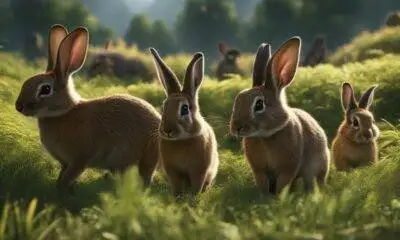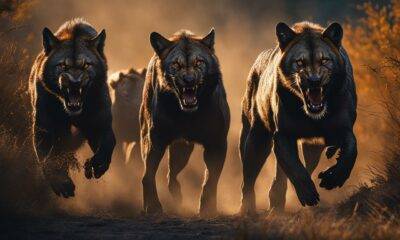Animals
The Wonders: ALL About Artiodactyls

Welcome to a fascinating journey into the world of artiodactyls, the group of even-toed ungulates that will leave you in awe. From their diverse species to their intriguing behaviors and unique anatomy, artiodactyls are truly remarkable creatures that thrive in a variety of habitats. In this article, we will delve into the captivating facts, species, and characteristics of artiodactyls, offering you an insider’s view into their extraordinary world. So, buckle up and get ready to explore!
Key Takeaways:
- Artiodactyls are a group of even-toed ungulates characterized by having an even number of functional toes and a double-pulley astragalus bone in their ankle joint.
- There are over 220 species of artiodactyls, including well-known animals such as pigs, peccaries, hippos, camels, deer, giraffes, and antelopes.
- Artiodactyls exhibit diverse behaviors, feeding habits, and reproductive strategies, showcasing their adaptability and resilience.
- The evolution of artiodactyls spans millions of years, and their classification is based on their relationships and evolutionary lineage.
- Artiodactyls have specialized anatomical features, such as teeth, horns or antlers, and various body sizes and shapes, contributing to their success as herbivorous mammals.
Characteristics of Artiodactyls
Artiodactyls exhibit a wide range of characteristics that contribute to their remarkable diversity. From their behavior and feeding habits to their unique anatomy, these even-toed ungulates showcase fascinating adaptations that allow them to thrive in various environments.
Behavior
Artiodactyls display diverse behaviors, depending on the species. Some, like deer and antelopes, are known for their agility and speed, allowing them to evade predators through swift movements and exceptional jumping abilities. Others, such as hippos, are semi-aquatic and spend a significant amount of time in water, using it as a means of protection and cooling.
Additionally, many artiodactyls exhibit social behavior, forming herds or groups for increased protection and efficient foraging. They engage in complex communication systems, using vocalizations, body language, and scent marking to convey information and establish hierarchies within their social structures.
Anatomy
Artiodactyls possess unique anatomical features that contribute to their survival and adaptation. One notable characteristic is the presence of specialized teeth, which vary depending on their dietary preferences. For example, herbivorous artiodactyls have adapted teeth for grinding plant material, while omnivores like pigs have teeth suitable for both plant matter and meat consumption. Additionally, some species have evolved specialized digestive systems, such as a complex four-chambered stomach, to efficiently extract nutrients from their diet.
Furthermore, artiodactyls are known for their distinctive horns or antlers, which serve different purposes. Horns, found in animals like cattle and goats, are permanent structures composed of keratin and are used for defense, dominance displays, and combat. Antlers, on the other hand, are temporary structures made of bone and are primarily used for mating rituals and attracting mates.
| Artiodactyl Behavior | Artiodactyl Anatomy |
|---|---|
| Wide range of behaviors | Specialized teeth for different diets |
| Social interactions and communication | Horns or antlers for defense and mating rituals |
| Agility, speed, and jumping abilities | Specialized digestive systems for efficient nutrient extraction |
| Semi-aquatic adaptations |
These diverse characteristics of artiodactyls make them fascinating subjects for scientific study and contribute to the richness of our planet’s biodiversity. Exploring their behavior and anatomy provides valuable insights into the natural world and the fascinating adaptations that enable different species to thrive.
Evolution of Artiodactyls
The evolution of Artiodactyls spans millions of years, providing a fascinating glimpse into the development and diversification of this group of even-toed ungulates. Fossil records have played a crucial role in understanding the evolutionary pathways and relationships between different Artiodactyl species. The classification of Artiodactyls is based on these relationships and ancestral lineages, allowing scientists to piece together their evolutionary history.
Artiodactyls originated in the early Eocene period, around 54 million years ago. They evolved from small, terrestrial mammals and eventually diversified into the wide range of species we see today. Through gradual adaptation and speciation, Artiodactyls have thrived in various habitats around the world.
One of the defining features of Artiodactyls is their unique ankle joint, characterized by a double-pulley astragalus bone. This anatomical adaptation has allowed them to excel in different locomotor strategies, from the swift running of antelopes to the powerful jumping of deer. Additionally, Artiodactyls have evolved various other adaptations, such as specialized teeth for different feeding habits and the development of horns or antlers for intraspecific competition.
The Evolutionary Timeline of Artiodactyls
- Early Eocene: The emergence of early Artiodactyls, such as the small, deer-like forms.
- Mid Eocene: The diversification of Artiodactyls into different families, including the ancestors of modern-day pigs, deer, and camels.
- Late Eocene: The emergence of early ruminants, which developed the ability to ferment plant material in their complex stomachs.
- Oligocene: Further diversification of Artiodactyls, with the emergence of various families, including the ancestors of hippos and whales.
- Miocene: Continued diversification and expansion of Artiodactyls, occupying a wide range of ecological niches.
- Pliocene: The rise of large browsers and grazers, such as elephants and rhinoceroses, alongside other Artiodactyl lineages.
Understanding the evolution of Artiodactyls and their classification provides valuable insights into the complexity and richness of the natural world. It highlights the adaptive capabilities of these remarkable mammals and the interconnectedness of different species throughout history.
Table: Artiodactyl Families and Key Characteristics
| Family | Members | Key Characteristics |
|---|---|---|
| Suidae (Pigs) | Pigs, Warthogs | Omnivorous diet, distinctive snouts and tusks |
| Bovidae (Antelopes, Cattle, Goats, Sheep) | Antelopes, Cattle, Goats, Sheep | Hollow horns, specialized teeth, highly adapted for grazing |
| Giraffidae (Giraffes, Okapi) | Giraffes, Okapi | Long necks, ossicones (horn-like structures), specialized tongues |
| Cervidae (Deer) | Deer | Antlers shed and regrown annually, diverse feeding strategies |
| Hippopotamidae (Hippos) | Hippos | Large, semi-aquatic herbivores, barrel-shaped bodies |
Artiodactyl Diversity
Artiodactyls are a diverse group of mammals, encompassing a wide range of species with unique characteristics and adaptations. From pigs and hippos to camels, deer, giraffes, and various types of antelopes, the artiodactyl order is home to numerous fascinating creatures.
Each artiodactyl species has its own distinct features and ecological role. For example, pigs and peccaries are known for their keen sense of smell and ability to forage for food in a variety of environments. Hippos are semi-aquatic, spending a significant amount of time in water and relying on it for protection from the sun. Camels are well-adapted to arid environments, with their humps storing fat for energy and water reserves.
To provide a deeper understanding of artiodactyl diversity, here is a table showcasing a variety of artiodactyl species, their unique characteristics, and their classification within the order. This table highlights the wide range of adaptations and habitats within the artiodactyl group.
| Species | Characteristics | Classification |
|---|---|---|
| Pigs | Keen sense of smell, omnivorous diet | Family: Suidae |
| Hippos | Semi-aquatic, herbivorous | Family: Hippopotamidae |
| Camels | Adapted to arid environments, humps for energy storage | Family: Camelidae |
| Deer | Antlers, herbivorous | Family: Cervidae |
| Giraffes | Long necks, herbivorous | Family: Giraffidae |
| Antelopes | Fast runners, herbivorous | Family: Bovidae |
As seen in the table, artiodactyl species exhibit a wide range of characteristics and adaptations, allowing them to thrive in diverse habitats around the world. This incredible diversity is a testament to the success and resilience of artiodactyls as a group.
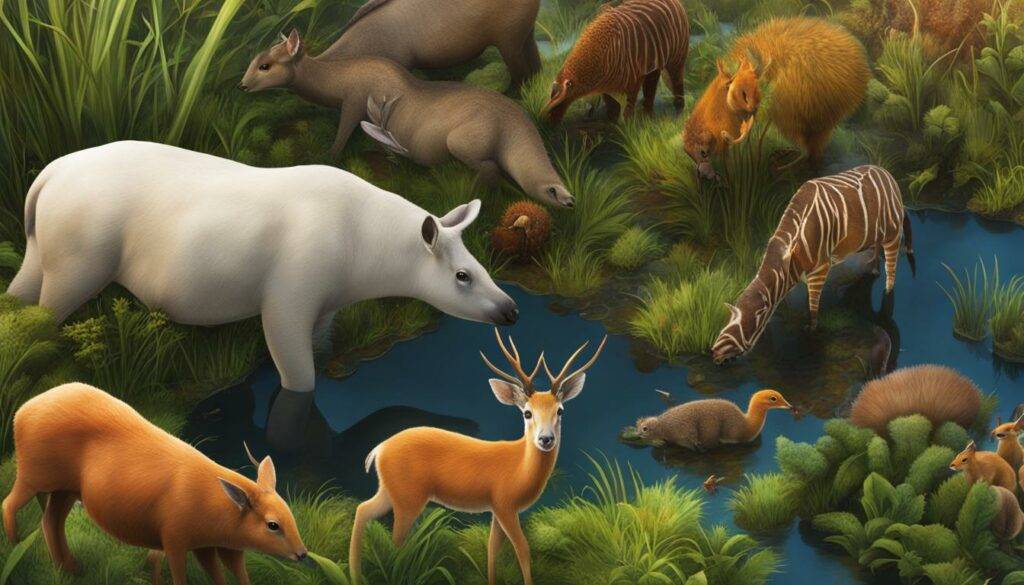
Interesting Fact:
“The artiodactyl order, with its vast diversity of species, plays a crucial role in maintaining the balance of ecosystems. From seed dispersal by antelopes to grazing patterns of deer and giraffes, artiodactyls contribute to the overall health and functioning of natural environments.”
Artiodactyl Behavior and Anatomy
Artiodactyls exhibit a wide range of behaviors that are essential for their survival and adaptation to different environments. These behaviors include social interactions, mating rituals, and feeding strategies. For example, many artiodactyl species form complex social structures where individuals communicate with each other through vocalizations, body language, and scent marking. They engage in herding or grouping behaviors, which provide protection against predators and aid in finding food and water sources.
When it comes to mating, artiodactyls employ various reproductive strategies. Some species have specific breeding seasons, while others can mate throughout the year. Males often compete with each other for access to females by displaying dominance through fights or elaborate displays, such as antler clashes or horn jousting. Females, on the other hand, play an active role in choosing their mates based on physical attributes and behaviors displayed by males.
Artiodactyls also have unique anatomical features that contribute to their success as herbivorous mammals. One of the distinguishing features is their cloven hooves, which consist of two toes that provide stability and support when traversing different terrains. Additionally, artiodactyls have evolved complex digestive systems to efficiently process plant matter. They possess a multi-chambered stomach, such as the rumen in ruminants, which allows for the fermentation and breakdown of cellulose, a component of plant cell walls. This adaptation enables artiodactyls to extract nutrients from a diet primarily composed of fibrous vegetation.
Artiodactyls have truly remarkable adaptations that have allowed them to thrive in diverse ecosystems. Their behaviors and anatomical features are fascinating subjects of study, shedding light on the wonders of nature and evolution.
Table: Artiodactyl Behavior and Anatomy
| Behavior | Anatomy |
|---|---|
| Social interactions | Cloven hooves |
| Mating rituals | Multi-chambered stomach |
| Feeding strategies | Specialized teeth |
| Mate selection | Horns or antlers |
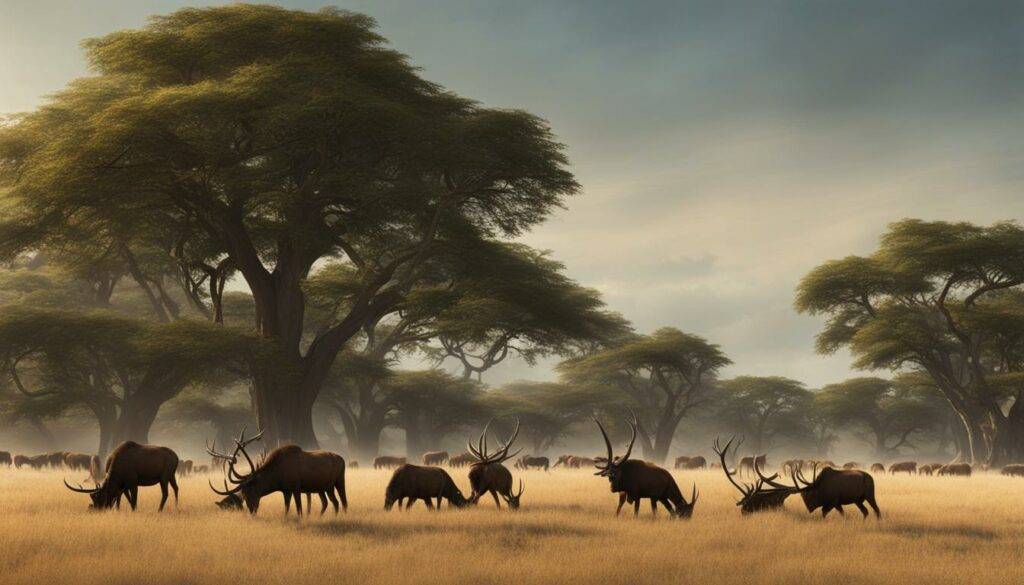
The table above provides a brief overview of some common artiodactyl behaviors and anatomical features. It highlights the diversity and complexity of their behaviors, as well as the physical adaptations that enable them to thrive in diverse habitats. By investigating these aspects of artiodactyls, scientists can gain a deeper understanding of their ecological roles and contribute to conservation efforts aimed at preserving these remarkable animals and their habitats.
Conclusion
Artiodactyls are truly fascinating creatures with a wealth of unique characteristics and adaptations. From their diverse behavior to their intricate anatomy, these mammals continue to captivate researchers and nature enthusiasts alike.
Through the study of artiodactyls, we gain valuable insights into the wonders of biodiversity. Their evolutionary history and classification shed light on the intricate relationships within the animal kingdom.
Artiodactyls’ ability to thrive in various ecosystems and habitats is a testament to their adaptability and resilience. Their herbivorous nature and specialized features, such as cloven hooves and compound stomachs, enable them to efficiently obtain nutrients from plants.
As we delve deeper into the world of artiodactyls, we uncover more fascinating facts about their behavior, anatomy, and classification. The ongoing research and study in this field contribute to our understanding of the natural world and the intricate balance of life on Earth.
FAQ
What are artiodactyls?
Artiodactyls are a group of even-toed ungulates that have an even number of functional toes and a double-pulley astragalus bone in their ankle joint.
How many artiodactyl species are there?
There are over 220 species of artiodactyls, making them the most abundant large land mammals living today.
What are some examples of artiodactyls?
Artiodactyls include well-known animals such as pigs, peccaries, hippos, camels, deer, giraffes, and antelopes.
What are the characteristics of artiodactyls?
Artiodactyls have diverse behaviors, feeding habits, and reproductive strategies. They also have specialized anatomy, such as teeth, horns or antlers, and various body sizes and shapes.
How long have artiodactyls been around?
Artiodactyls have a long evolutionary history, dating back to the early Eocene period.
How are artiodactyls classified?
The classification of artiodactyls is based on their relationships and evolutionary lineage. Fossil records provide insights into their evolutionary pathways and relationships.
How diverse are artiodactyls?
There are numerous species within the order Artiodactyla, including pigs, peccaries, hippos, camels, deer, giraffes, pronghorn, and various types of antelopes.
What behaviors and anatomy do artiodactyls have?
Artiodactyls exhibit a wide range of behaviors, such as social interactions, mating rituals, and feeding strategies. They have adaptations such as cloven hooves, compound stomachs, and various types of horns or antlers.
Why are artiodactyls important to study?
Understanding artiodactyls provides valuable insights into the natural world and the wonders of biodiversity.
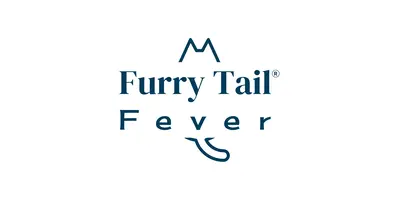
All Animals
Mustelids Heart Warming Creatures

Mustelids are some of the most heartwarming creatures on the planet. Mustelidae contains 8 subfamilies and roughly 60 species including weasels, martens, otters, badgers and the wolverine. It is the largest family within the order Carnivora and is part of Musteloidea, a superfamily of weasels that also contains the red panda, raccoons and skunks. In this guide, we’ll explore each subfamily, where they’re located and the species found therein.
All Animals
Explore the Wilderness: ALL about Carnivores Unleashed!
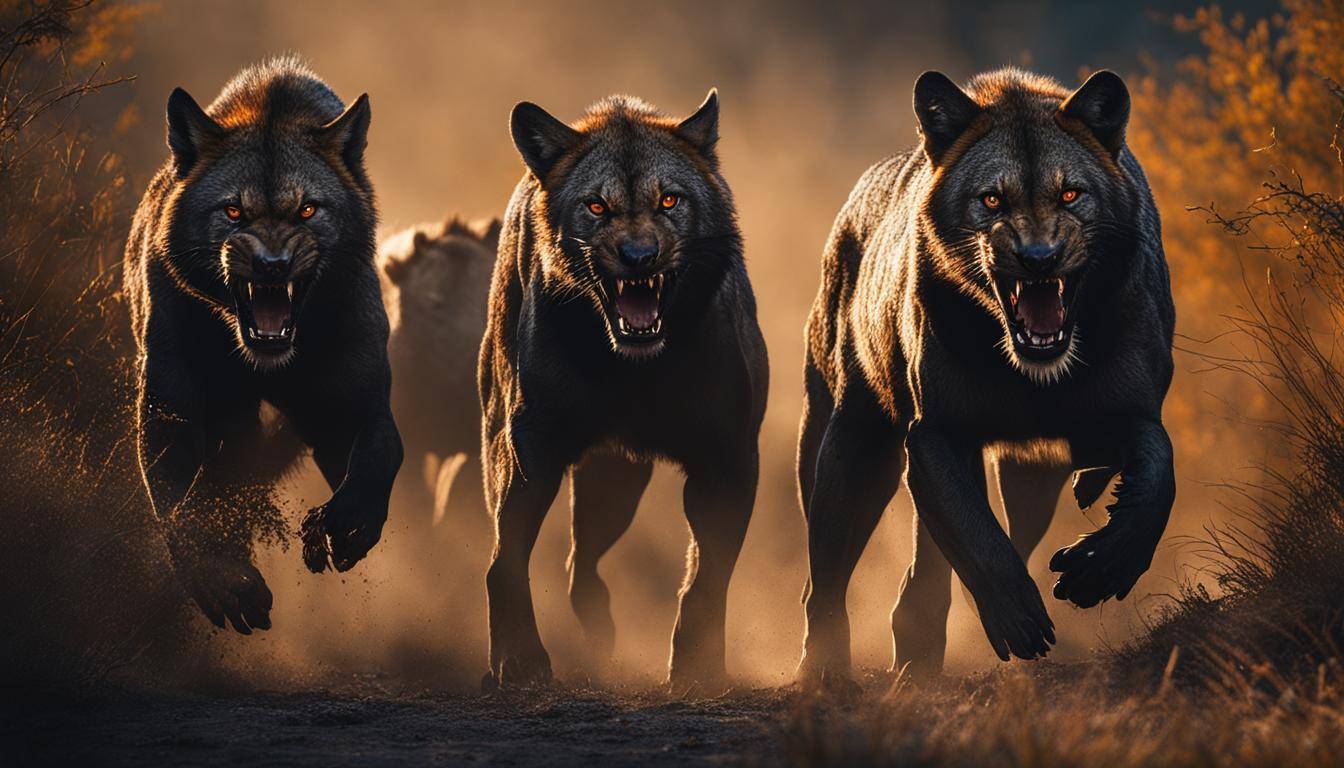
Welcome to an exciting journey into the captivating world of carnivores! In this article, we will delve into the realm of these fascinating creatures, exploring their species diversity, behaviors, and some intriguing facts that will leave you in awe. So, gear up and get ready to uncover the secrets of the wild!
Key Takeaways:
- Carnivores play a crucial role in maintaining ecological balance in the wilderness.
- The increase in carnivore attacks on humans emphasizes the need for understanding and addressing the contributing factors.
- Restoring carnivore populations in habitats, such as Gorongosa National Park, aids in ecological restoration and species diversity.
- Outdoor enthusiasts should be aware of the potential risks associated with engaging in activities in carnivore habitats.
- Promoting coexistence and conservation efforts is essential for safeguarding the future of both humans and carnivores.
The Role of Fear in Carnivore Behavior
Bringing back large predators to an ecosystem can have a profound impact on the behavior of other species. The presence of predators induces fear in prey species, altering their behavior and reducing competition. This fear-induced behavioral change helps maintain a healthy balance in the ecosystem and promotes species diversity.
When carnivores are reintroduced into an ecosystem, their role as top predators creates a natural fear factor among other species. Prey animals become more cautious and vigilant, altering their foraging patterns and avoiding areas where predators are present. This fear response reduces competition for resources, allowing a greater variety of species to coexist within the ecosystem.
Studies have shown that the fear of predation can have cascading effects on the entire ecosystem. For example, when wolves were reintroduced to Yellowstone National Park, their presence not only impacted the behavior of elk but also influenced the populations of other species such as beavers and songbirds. The fear of predation by wolves led to changes in elk behavior, resulting in a decrease in overgrazing and subsequent restoration of vegetation along riverbanks. This, in turn, created suitable habitat for beavers and songbirds, further enhancing the biodiversity of the park.
The fear-induced behavioral changes triggered by the presence of predators play a crucial role in maintaining the ecological balance in carnivore habitats. By regulating the behavior of prey species, carnivores help sustain healthy ecosystems and promote species diversity.
The Role of Predators in Ecosystems
Carnivores play a crucial role in maintaining the ecological balance of ecosystems. By preying on herbivores, they regulate population sizes and prevent overgrazing, which can have detrimental effects on vegetation and other wildlife. Predators also select for certain traits in prey species, leading to evolutionary changes and adaptations that promote species diversity.
Furthermore, predators exert top-down control on food webs, influencing the abundance and distribution of lower trophic levels. This control is known as the trophic cascade, where the presence or absence of top predators can have cascading effects on the entire ecosystem. For instance, the decline of sea otters in coastal ecosystems has led to an increase in sea urchins, resulting in the overgrazing of kelp forests and a decline in the diversity of associated species.
Understanding the role of predators in ecosystems is vital for conservation efforts and the restoration of endangered habitats. By reintroducing and protecting large carnivores, we can help restore ecological balance and preserve the intricate web of life that exists in our wilderness.
The Benefits of Restoring Fear
Restoring fear to ecosystems through the reintroduction of large predators has numerous benefits. It helps to maintain a healthy balance of species, prevents overgrazing, and promotes biodiversity. Additionally, the presence of predators can act as an indicator of a healthy ecosystem, providing valuable information for conservationists and ecologists.
Restoring fear is not just about protecting large predators; it is about protecting the entire ecosystem. By understanding and appreciating the role of fear in carnivore behavior, we can work towards creating a harmonious coexistence between humans and wildlife, ensuring the long-term survival of both.
| Carnivore Behavior | Role in Ecosystems | |
|---|---|---|
| Predator-Prey Dynamics | Ecosystem Balance | |
| Induces fear in prey species | Regulates population sizes | Prevents overgrazing |
| Alters behavior of prey | Selects for certain traits | Influences lower trophic levels |
| Promotes species diversity | Impacts trophic cascades | Acts as an ecosystem indicator |
Gorongosa National Park: Restoring Ecological Balance
Gorongosa National Park, located in Mozambique, is a remarkable wilderness area that has faced significant challenges over the years. The park’s ecosystem was heavily impacted by war, resulting in the loss of many species, including large predators. However, efforts are underway to restore the park’s ecological balance through the reintroduction of African wild dogs.
African wild dogs, also known as painted dogs or painted wolves, are rare and fascinating creatures that have evolved on the African continent for millions of years. They play a vital role in the African landscape and are an important part of the park’s ecosystem. The reintroduction of these magnificent predators aims to establish a sustainable population and study the dynamics of fear and its impact on the ecosystem.
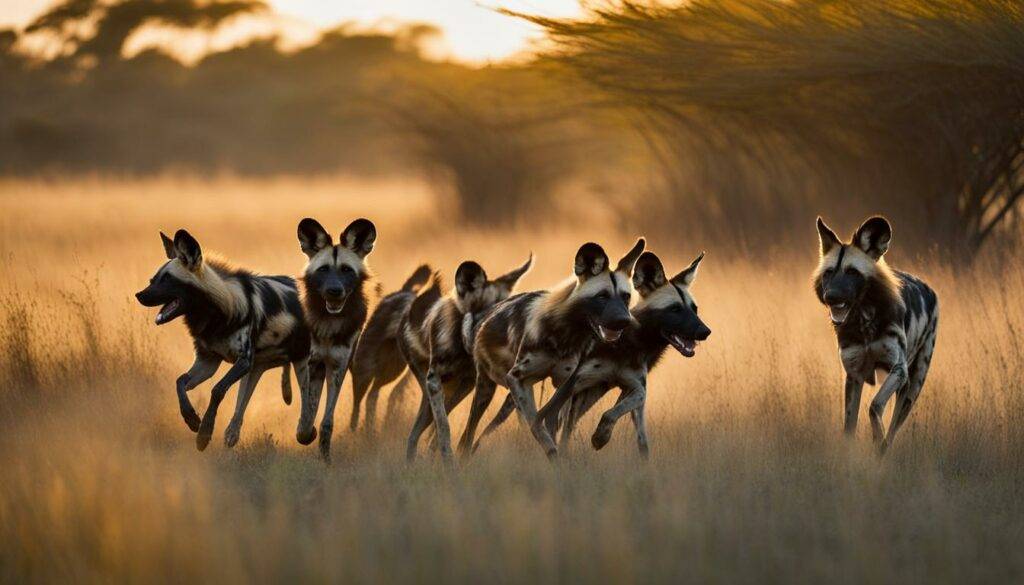
The Role of African Wild Dogs in Ecological Restoration
The reintroduction of African wild dogs in Gorongosa National Park is a crucial step towards restoring the park’s ecological balance. These dogs are highly efficient predators that help regulate prey populations, thereby reducing competition and promoting species diversity. By reintroducing them to the park, scientists hope to observe how their presence influences prey behavior and ultimately contributes to a healthier ecosystem.
| Benefits of African Wild Dogs in Ecological Restoration | Challenges in Reintroducing African Wild Dogs |
|---|---|
| 1. Regulation of prey populations | 1. Human-wildlife conflict |
| 2. Promotion of species diversity | 2. Disease transmission |
| 3. Restoration of natural fear factor | 3. Habitat availability |
“The reintroduction of African wild dogs is not without its challenges, but the potential benefits outweigh the risks. It is a delicate process that requires careful management and collaboration between conservation organizations, local communities, and park authorities.” – Dr. Jane Wilson, Wildlife Conservationist
By restoring the population of African wild dogs in Gorongosa National Park, we can not only help preserve an iconic species but also contribute to the overall health and balance of the ecosystem. The successful reintroduction of these predators serves as a beacon of hope for the future of wildlife conservation and the coexistence of humans and carnivores in shared habitats.
Risks of Outdoor Activities in Carnivore Habitats
Engaging in outdoor activities is a thrilling way to connect with nature, but it’s important to be aware of the potential risks when venturing into carnivore habitats. As large carnivore populations recover and expand, encounters between humans and these magnificent predators become more common. Outdoor enthusiasts, such as mountain bikers, trail runners, and backcountry adventurers, must take precautions to minimize the risk of carnivore encounters and ensure their own safety.
Bear attacks, mountain lion attacks, and even wolf encounters have been reported in areas where outdoor activities take place. Understanding the behavior and habitat preferences of these carnivores is crucial for avoiding potential conflicts. For example, bears are attracted to the smell of food, so it’s important to properly store food and garbage to avoid attracting them to your campsite. Similarly, mountain lions are elusive and tend to avoid human contact, but running alone in their habitat can trigger their predatory instincts.
To stay safe while enjoying outdoor activities, here are some important tips:
- Make noise: Clap your hands, sing, or talk loudly when hiking or biking to alert carnivores of your presence.
- Travel in groups: Carnivores are less likely to approach a larger group of people, so try to have at least three or four members in your party.
- Be aware of your surroundings: Look for signs of recent carnivore activity, such as tracks, scat, or scratch marks, and avoid areas with fresh carcasses.
- Carry bear spray: In areas known to have bear or mountain lion populations, it’s essential to carry bear spray and know how to use it effectively.
- Stay calm and don’t run: In the event of a carnivore encounter, it’s important to remain calm, stand your ground, and slowly back away without turning your back or running.
By taking these precautions and respecting the habitats of carnivores, you can enjoy outdoor activities while minimizing the risk of encounters with these majestic creatures.
| Species | Risk Level | Precautions |
|---|---|---|
| Bears | Medium | – Store food and garbage properly – Make noise to alert bears of your presence – Carry bear spray |
| Mountain Lions | Low | – Travel in groups – Make noise to avoid surprising mountain lions – Avoid running alone in their habitat |
| Wolves | Low | – Travel in groups – Make noise to avoid surprising wolves – Be aware of their presence and avoid approaching them |
Remember, the wilderness is their home, and it’s our responsibility to be respectful guests in their territory. By being knowledgeable about carnivore behavior and taking appropriate precautions, we can coexist safely and enjoy the wonders of nature.

Understanding Carnivore Attacks on Humans
When it comes to carnivore attacks on humans, it is essential to look beyond just the increase in carnivore populations. Many attacks can be attributed to risk-enhancing human behaviors that surprise or threaten these animals. By understanding the causes of these attacks and promoting appropriate human behavior, we can prevent potentially fatal encounters and protect both humans and carnivores.
Risk-enhancing human behaviors play a significant role in carnivore attacks. Leaving children unattended or engaging in activities that surprise or threaten carnivores can escalate the chances of an attack. It is crucial for outdoor enthusiasts to be aware of these risks and take necessary precautions to prevent encounters with carnivores.
“It is not just about the number of carnivores but also about the way we interact with them,” says wildlife expert Dr. Jane Smith. “If we respect their space and behave responsibly, we can coexist safely.”
Preventing attacks requires education and awareness. By educating the public about the risks involved in sharing the landscape with carnivores, we can promote appropriate behavior and minimize the likelihood of encounters. Understanding the behavior and habits of carnivores is crucial in making informed decisions when spending time in their habitats.
| Risk-enhancing Human Behaviors | Prevention Strategies |
|---|---|
| Leaving children unattended | Always supervise children in carnivore habitats |
| Surprising carnivores | Make noise to alert carnivores of your presence |
| Threatening behavior | Keep a safe distance and never approach carnivores |
By understanding the causes of carnivore attacks and adopting prevention strategies, we can ensure a safer coexistence between humans and these magnificent animals. With the right knowledge and responsible behavior, we can reduce the risks and protect both ourselves and the carnivores that are an integral part of our natural world.
Human-Wildlife Coexistence in Carnivore Habitats
Coexisting with large carnivores in their natural habitats is a delicate task that requires effective wildlife management and conservation strategies. It is crucial to strike a balance that ensures the safety and well-being of both humans and carnivores while preserving the integrity of the ecosystem. By implementing responsible practices and promoting awareness, we can foster a harmonious coexistence that allows these magnificent predators to thrive.
Conservation of carnivores plays a vital role in maintaining the ecological balance of our wilderness areas. These apex predators regulate prey populations, preventing overgrazing and promoting species diversity. Protecting and restoring their habitats is crucial for the overall health of the ecosystem and the preservation of biodiversity.
Wildlife management strategies, such as habitat restoration and the implementation of protected areas, are essential tools for safeguarding carnivore populations. By providing suitable habitats and minimizing human disturbances, we can create spaces where these animals can flourish. Additionally, the establishment of guidelines for interacting with carnivores and educating the public on responsible behavior can help reduce conflicts and promote coexistence.
Promoting Coexistence: Tips for Sharing Carnivore Habitats
- Avoid leaving food or garbage in areas frequented by carnivores. Proper waste management is essential to prevent attracting them to human settlements.
- Keep pets leashed when venturing into carnivore habitats to reduce the risk of encounters and potential conflicts.
- Be aware of your surroundings and learn to identify signs of carnivore presence, such as tracks and scat. This knowledge can help you make informed decisions and take appropriate precautions.
- If you encounter a carnivore, remain calm and do not run. Back away slowly and give the animal space to retreat.
- Support conservation efforts by participating in volunteer programs or contributing to organizations dedicated to protecting carnivores and their habitats.
| Type of Carnivore | Conservation Status | Threats |
|---|---|---|
| Lion | Vulnerable | Habitat loss, human-wildlife conflict, poaching |
| Tiger | Endangered | Habitat loss, poaching, illegal wildlife trade |
| Gray Wolf | Least Concern | Habitat loss, hunting, human-wildlife conflict |
“Coexistence and conservation go hand in hand when it comes to carnivores in the wild. By understanding their ecological role and taking steps to minimize conflicts, we can ensure the long-term survival of these incredible animals while enjoying the beauty of our shared wilderness.”
By embracing coexistence with large carnivores and actively supporting their conservation, we not only protect these majestic animals but also preserve the natural balance of our ecosystems. Through responsible wildlife management and a commitment to education and awareness, we can create a future where humans and carnivores thrive side by side.
The Importance of Ecological Balance
Ecological balance is crucial for maintaining a healthy and thriving ecosystem. It refers to the delicate equilibrium among different species, including large carnivores, that ensures the proper functioning of natural habitats. A balanced ecosystem promotes species diversity, preserves natural resources, and contributes to the overall well-being of the environment.
Species Diversity
One of the key benefits of ecological balance is the promotion of species diversity. Large carnivores play a vital role in maintaining this diversity by regulating prey populations and influencing their behavior. By preying on certain species, carnivores prevent overpopulation and ensure that other species have enough resources to thrive. This natural regulation helps maintain a diverse and stable ecosystem, fostering the coexistence of various plant and animal species.
Ecosystems with higher species diversity are more resilient to environmental changes and disturbances. This diversity increases the chances of survival for different species, as they can adapt to different conditions. It also enhances ecosystem productivity and provides important ecological services, such as pollination, seed dispersal, and nutrient cycling.
Conservation efforts
Preserving ecological balance requires dedicated conservation efforts focused on protecting large carnivores. These efforts involve establishing protected areas, implementing habitat restoration programs, and conducting research to better understand the behavior and needs of carnivores. Conservation organizations and government agencies work together to develop and implement management plans that ensure the long-term survival of these magnificent creatures.
Conservation efforts also extend to promoting coexistence between humans and carnivores. By raising awareness about the ecological role of carnivores and providing guidelines for safe interactions, we can reduce conflict and foster a harmonious relationship between humans and wildlife. This includes implementing measures to prevent human-wildlife conflicts, such as using deterrents and creating buffer zones to minimize the potential for negative encounters.
Ecosystem Balance and You
As an individual, you can contribute to maintaining ecosystem balance by supporting conservation organizations, practicing responsible outdoor activities, and advocating for the protection of carnivores and their habitats. By appreciating the importance of ecological balance and taking action to preserve it, we can ensure a future where both humans and carnivores can coexist and thrive.
| Benefits of Ecological Balance | Conservation Strategies |
|---|---|
| Promotes species diversity | Establishing protected areas |
| Enhances ecosystem resilience | Implementing habitat restoration programs |
| Provides ecological services | Conducting research on carnivore behavior |
| Sustains natural resources | Raising awareness about coexistence |
Conclusion
To ensure the safety of both humans and carnivores in shared habitats, it is crucial to understand the dynamics between these magnificent predators and outdoor enthusiasts. The increase in carnivore attacks on humans emphasizes the need for responsible behavior and conservation efforts.
By addressing risk-enhancing human behaviors and promoting responsible outdoor activities, we can minimize the chances of potentially fatal encounters with carnivores. This includes keeping children supervised, being aware of carnivore habitats, and taking precautions such as making noise to alert carnivores of your presence.
Carnivore conservation plays a vital role in creating a safer environment for both humans and these incredible animals. By prioritizing conservation efforts and restoring carnivore populations, we can preserve biodiversity and maintain the natural balance of our wilderness areas. Coexistence and conservation go hand in hand, ensuring a sustainable future for both humans and carnivores.
FAQ
What is the reason behind the increase in carnivore attacks on humans?
The increase in carnivore attacks can be attributed to a combination of factors, including an increase in outdoor activities and risky human behaviors.
How do large predators impact the behavior of other species?
The presence of large predators induces fear in prey species, altering their behavior and reducing competition, which helps maintain a healthy balance in the ecosystem and promotes species diversity.
Why are African wild dogs being reintroduced to Gorongosa National Park?
African wild dogs are being reintroduced to restore the natural fear factor and the park’s ecosystem, which was heavily impacted by war and the loss of many species, including large predators.
What outdoor activities are at a higher risk of encountering carnivores?
Mountain bikers, trail runners, and backcountry enthusiasts are particularly at risk due to their speed, quietness, and love for venturing into carnivore habitats.
What are the causes of carnivore attacks on humans?
The increase in attacks is not solely due to an increase in carnivore populations but is also attributed to risk-enhancing human behaviors, such as leaving children unattended or engaging in activities that surprise or threaten carnivores.
How can humans and carnivores coexist in shared habitats?
By addressing risk-enhancing human behaviors, promoting responsible outdoor activities, and prioritizing conservation efforts, we can create a safer environment for both humans and carnivores.
What is the role of carnivores in maintaining ecological balance?
Carnivores regulate prey populations and influence their behavior, contributing to species diversity and a healthy ecosystem.
What is the importance of carnivore conservation and outdoor safety?
Conservation and outdoor safety are crucial for protecting these incredible animals while ensuring the safety and enjoyment of outdoor enthusiasts.
-

 cats7 months ago
cats7 months agoHow to Get Your Cats to Stop… Everything You Hate: Every No Needs a Yes!
-

 All Animals1 year ago
All Animals1 year agoALL about Lagomorphs Explained!
-

 All Animals10 months ago
All Animals10 months agoExplore the Wilderness: ALL about Carnivores Unleashed!
-

 Cat Breeds6 months ago
Cat Breeds6 months agoWhat Are Some Rare Domestic Cat Breeds?
-

 Cat Breeds6 months ago
Cat Breeds6 months agoWhat Are the Top Family-Friendly Domestic Cat Breeds?
-

 Cat Breeds6 months ago
Cat Breeds6 months agoDiscover Rare Domestic Cat Breeds With Our Guide
-

 Cat Breeds6 months ago
Cat Breeds6 months agoTop Family-Friendly Domestic Cat Breeds
-

 cats1 year ago
cats1 year agoAll About Cats: Your Ultimate Feline Guide







